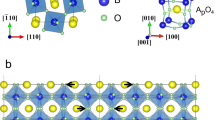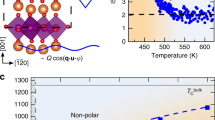Abstract
Hexagonal YMnO3 shows a unique improper ferroelectricity induced by structural trimerization. Extensive research on this system is primarily due to its candidacy for ferroelectric memory as well as the intriguing coexistence of ferroelectricity and magnetism. Despite this research, the true ferroelectric domain structure and its relationship with structural domains have never been revealed. Using transmission electron microscopy and conductive atomic force microscopy, we observed an intriguing conductive ‘cloverleaf’ pattern of six domains emerging from one point—all distinctly characterized by polarization orientation and structural antiphase relationships. In addition, we discovered that the ferroelectric domain walls and structural antiphase boundaries are mutually locked and this strong locking results in incomplete poling even when large electric fields are applied. Furthermore, the locked walls are found to be insulating, which seems consistent with the surprising result that the ferroelectric state is more conducting than the paraelectric state. These fascinating results reveal the rich physics of the hexagonal system with a truly semiconducting bandgap where structural trimerization, ferroelectricity, magnetism and charge conduction are intricately coupled.
This is a preview of subscription content, access via your institution
Access options
Subscribe to this journal
Receive 12 print issues and online access
$259.00 per year
only $21.58 per issue
Buy this article
- Purchase on Springer Link
- Instant access to full article PDF
Prices may be subject to local taxes which are calculated during checkout




Similar content being viewed by others
References
Cohen, R. E. Origin of ferroelectricity in perovskite oxides. Nature 358, 136–138 (1992).
Hill, N. A. Why are there so few magnetic ferroelectrics? J. Phys. Chem. B 104, 6694–6709 (2000).
Ramesh, R. & Spaldin, N. A. Multiferroics: Progress and prospects in thin films. Nature Mater. 6, 21–29 (2007).
Levanyuk, A. P. & Sannikov, D. G. Improper ferroelectrics. Sov. Phys. Usp. 17, 199–214 (1974).
Kimura, T. et al. Magnetic control of ferroelectric polarization. Nature 426, 55–58 (2003).
Hur, N. et al. Electric polarization reversal and memory in a multiferroic material induced by magnetic fields. Nature 429, 392–395 (2004).
Ikeda, N. et al. Ferroelectricity from iron valence ordering in the charge-frustrated LuFe2O4 . Nature 436, 1136–1138 (2005).
Van Aken, B. B., Palstra, T. T. M., Filippetti, A. & Spaldin, N. A. The origin of ferroelectricity in magnetoelectric YMnO3 . Nature Mater. 3, 164–170 (2004).
Fennie, C. J. & Rabe, K. M. Ferroelectric transition in YMnO3 from first principles. Phys. Rev. B 72, 100103 (2005).
Eerenstein, W., Mathur, N. D. & Scott, J. F. Multiferroic and magnetoelectric materials. Nature 442, 759–765 (2006).
Cheong, S.-W. & Mostovoy, M. Multiferroics: A magnetic twist for ferroelectricity. Nature Mater. 6, 13–20 (2007).
Mitsui, T. & Furuichi, J. Domain structure of Rochelle salt and KH2PO4 . Phys. Rev. 90, 193–202 (1953).
Fiebig, M. et al. Observation of coupled magnetic and electric domains. Nature 419, 818–820 (2002).
Lottermoser, T. et al. Magnetic phase control by an electric field. Nature 430, 541–544 (2004).
Fujimura, N., Ishida, T., Yoshimura, T. & Ito, T. Epitaxially grown YMnO3 film: New candidate for nonvolatile memory devices. Appl. Phys. Lett. 69, 1011–1013 (1996).
Choi, T. & Lee, J. Bi modification for low-temperature processing of YMnO3 thin films. Appl. Phys. Lett. 84, 5043–5045 (2004).
Lorenz, B., Litvinchuk, A. P., Gospodinov, M. M. & Chu, C. W. Field-induced reentrant novel phase and a ferroelectric–magnetic order coupling in HoMnO3 . Phys. Rev. Lett. 92, 087204 (2004).
Spaldin, N. A. & Fiebig, M. The renaissance of magnetoelectric multiferroics. Science 309, 391–392 (2005).
Woodall, J. M. III–V Compounds and alloys: An update. Science 208, 908–915 (1980).
Medvedeva, J. E., Anisimov, V. I., Korotin, M. A., Mryasov, O. N. & Freeman, A. J. The effect of Coulomb correlation and magnetic ordering on the electronic structure of two hexagonal phases of ferroelectromagnetic YMnO3 . J. Phys. Condens. Matter 12, 4947–4958 (2000).
Seidel, J. et al. Conduction at domain walls in oxide multiferroics. Nature Mater. 8, 229–234 (2009).
Choi, T., Lee, S., Choi, Y. J., Kiryukhin, V. & Cheong, S.-W. Switchable ferroelectric diode and photovoltaic effect in BiFeO3 . Science 324, 63–66 (2009).
Maksymovych, P. et al. Polarization control of electron tunnelling into ferroelectric surfaces. Science 324, 1421–1425 (2009).
Garcia, V. et al. Giant tunnel electroresistance for non-destructive readout of ferroelectric states. Nature 460, 81–84 (2009).
Aird, A. & Salje, E. K. H. Sheet superconductivity in twin walls: Experimental evidence of WO3−x . J. Phys. Condens. Matter 10, L377–L380 (1998).
Bartels, M. et al. Impurity-induced resistivity of ferroelastic domain walls in doped lead phosphate. J. Phys. Condens. Matter 15, 957–962 (2003).
Ihlefeld, J. F. et al. Optical band gap of BiFeO3 grown by molecular-beam epitaxy. Appl. Phys. Lett. 92, 142908 (2008).
Cardona, M. Optical properties and band structure of SrTiO3 and BaTiO3 . Phys. Rev. 140, A651–A655 (1965).
Katsufuji, T. et al. Dielectric and magnetic anomalies and spin frustration in hexagonal RMnO3 (R=Y, Yb and Lu). Phys. Rev. B 64, 104419 (2001).
Chen, C. H., Gibson, J. M. & Fleming, R. M. Direct observation of charge-density-wave discommensurations and dislocations in 2H–TaSe2 . Phys. Rev. Lett. 47, 723–725 (1981).
Tanaka, M. & Honjo, G. Electron optical studies of barium titanate single crystal films. J. Phys. Soc. Jpn 19, 954–970 (1964).
Spaldin, N. A. Fundamental size limits in ferroelectricity. Science 304, 1606–1607 (2004).
Landuyt, J., Gevers, R. V. & Amelinckx, S. Fringe patterns at anti-phase boundaries with α=π observed in the electron microscope. Phys. Status Solidi 7, 519–546 (1964).
Nénert, G. et al. Experimental evidence for an intermediate phase in the multiferroic YMnO3 . J. Phys. Condens. Matter 19, 466212 (2007).
Wemple, S. H. Polarization fluctuations and the optical-absorption in BaTiO3 . Phys. Rev. B. 2, 2679–2689 (1981).
Palaniappan, L., Gnanam, F. D. & Ramasamy, P. Electrical characterization of SbSI grown from the melt by a temperature fluctuation technique. J. Mater. Sci. Lett. 5, 1007–1008 (1986).
Cho, D.-Y. et al. Ferroelectricity driven by Y d0-ness with rehybridization in YMnO3 . Phys. Rev. Lett. 98, 217601 (2007).
Wood, V. E., Austin, A. E., Collins, E. W. & Brog, K. C. Magnetic properties of heavy-rare-earth orthomanganites. J. Phys. Chem. Solids 34, 859–868 (1973).
Pintilie, L., Vrejoiu, I., Hesse, D., LeRhun, G. & Alexe, M. Ferroelectric polarization-leakage current relation in high quality epitaxial Pb(Zr,Ti)O3 films. Phys. Rev. B 75, 104103 (2007).
Kim, S. H. et al. Growth, ferroelectric properties, and phonon modes of YMnO3 single crystal. Cryst. Res. Technol. 35, 19–27 (2000).
Acknowledgements
We would like to thank S. W. Fackler (Rutgers), J. J. Cheong (Columbia), V. Kiryukhin (Rutgers) and M. Tanimura (NISSAN ARC) for useful discussions. This work was supported by NSF-DMR-0804109 and NSF-DMR-0844807.
Author information
Authors and Affiliations
Contributions
S.-W.C. grew single-crystalline specimens, designed the research project and supervised the experiments. T.C. carried out CAFM experiments with the help of W.W. and carried out electrical transport measurements with the help of Y.J.C. Y.H. collected TEM data and analysed structural properties. H.T.Y. prepared CAFM specimens. S.-W.C., T.C. and Y.H. co-wrote the paper, and all authors discussed the results.
Corresponding author
Ethics declarations
Competing interests
The authors declare no competing financial interests.
Supplementary information
Supplementary Information
Supplementary Information (PDF 998 kb)
Rights and permissions
About this article
Cite this article
Choi, T., Horibe, Y., Yi, H. et al. Insulating interlocked ferroelectric and structural antiphase domain walls in multiferroic YMnO3. Nature Mater 9, 253–258 (2010). https://doi.org/10.1038/nmat2632
Received:
Accepted:
Published:
Issue Date:
DOI: https://doi.org/10.1038/nmat2632
This article is cited by
-
Multiferroic and photocatalytic properties of DyFeO3 nanoparticles stabilized by citrate precursor route
Bulletin of Materials Science (2024)
-
Maxwell–Wagner-type relaxation behavior through impedance spectral analysis of YMnO3 single crystal
Journal of the Korean Physical Society (2023)
-
Three-state nematicity and magneto-optical Kerr effect in the charge density waves in kagome superconductors
Nature Physics (2022)
-
Titanium doped yttrium manganite: improvement of microstructural properties and peculiarities of multiferroic properties
Journal of Sol-Gel Science and Technology (2022)
-
The Magnetic Peculiarity and the Optoelectronic Properties of Pr2CrMnO6 from DFT and Monte Carlo Simulation
Journal of Superconductivity and Novel Magnetism (2022)



